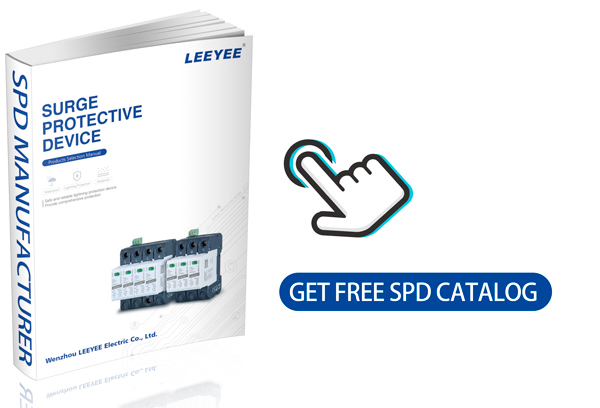Lightning strikes can destroy infrastructure instantly, cause data loss, and start fires. LEEYEE offers certified lightning protection systems for solar, industrial, and telecom sites, preventing costly disasters.
A lightning protection system is a structural and electrical system designed to safely intercept and redirect lightning strikes into the ground, preventing damage to buildings and sensitive electronics. It typically includes air terminals, down conductors, grounding electrodes, and surge protective devices (SPDs). These systems are essential for industrial, solar, and critical infrastructure in high-risk lightning zones.
Let’s explore how lightning protection systems work and why they are indispensable in today’s electrical environments.
Is a lightning protection system worth it?
Yes, absolutely—especially for facilities located in lightning-prone regions or operating critical infrastructure like data centers, PV plants, or telecom towers. A single lightning strike can inject over 100 million volts and carry currents exceeding 200kA. Without proper grounding and surge control, such energy can destroy transformers, solar inverters, PLCs, and sensitive electronics. Beyond equipment loss, lightning can cause fires, explosions, e life-threatening hazards. In fact, according to the NFPA (National Fire Protection Association), lightning is a leading cause of structural fires in industrial zones. Given the relatively low cost of a certified lightning protection system, the return on prevention investment is substantial and measurable.
Which is the best lightning protection system?
The best lightning protection system is one that is custom-designed to suit the structural, electrical, and environmental characteristics of the facility. An effective system typically includes:
-
Air terminals (lightning rods) to capture strikes.
-
Down conductors that carry current safely to ground.
-
Earthing systems (grounding electrodes) with resistance typically below 10Ω.
-
Dispositivi di protezione dalle sovratensioni (SPD) at all power and communication entry points.
Among the top solutions, modular lightning protection systems with replaceable components are gaining popularity for ease of maintenance. LEEYEE’s lightning protection solutions, for example, are designed for PV systems, data centers, power substations, and EV charging stations. With high surge capacity (Imax up to 100kA) and fast response (<25ns), LEEYEE systems meet IEC 62305 e IEC 61643 standards, making them highly reliable for mission-critical infrastructure.
What is the difference between a surge protector and a lightning protection system?
While both systems aim to protect electrical infrastructure, their functions and components differ significantly:
| Caratteristica | Surge Protector (SPD) | Lightning Protection System |
|---|---|---|
| Scopo | Diverts overvoltage from internal/external surges | Directs full lightning strike energy safely to ground |
| Installazione | Electrical panels, devices | Building rooftops, structural framework |
| Componenti | MOVs, gas discharge tubes | Air terminals, down conductors, ground rods |
| Standard | IEC 61643-11 | IEC 62305-3 |
In essence, SPDs handle residual energy, often after the main lightning current has been redirected by the structural protection system. They are complementary—not interchangeable. For complete protection, both systems must work in tandem.
What is the difference between a lightning arrester and a lightning protection system?
Although often confused, a lightning arrester is only one component within a broader lightning protection strategy. Here’s the distinction:
-
A lightning arrester is a device connected to a power line that protects electrical equipment by diverting surge voltage to the ground.
-
A lightning protection system, however, encompasses the whole architecture—rods, conductors, grounding networks, and surge components—designed to intercept lightning strikes before they reach equipment.
Arresters are commonly used in medium- and high-voltage systems, such as substations, whereas full protection systems are required for buildings, solar installations, or communication towers.
At LEEYEE, both lightning arresters e full lightning protection assemblies are available. The company’s engineered solutions provide layered protection, ensuring that both structural and electrical threats are mitigated effectively.
Conclusione
A properly designed lightning protection system safeguards infrastructure, data, and lives—it’s a critical investment, not an optional upgrade.
Why LEEYEE?
LEEYEE is a trusted manufacturer in the lightning protection and surge control industry, offering turnkey solutions for solar systems, telecom infrastructure, industrial automation, and substations. With over 15 years of experience and an 8,000m² factory, LEEYEE provides SPDs, lightning rods, PV combiner boxes, and modular protection systems.
All products are TUV, CE, CB, and ISO9001 certified, with surge parameters such as:
-
Nominal discharge current (In): 20kA
-
Maximum discharge current (Imax): up to 100kA
-
Response time: <25ns
-
Voltage protection level (Up): <2.5kV (DC), <1.8kV (AC)
LEEYEE supports OEM/ODM, offers custom engineering consultation, and ensures fast global shipping. The company also welcomes on-site inspections, verification reports, and video audits.
FAQs: Lightning Protection System
Q1: Do I need a lightning protection system for my solar plant?
Yes. Solar arrays and inverters are highly vulnerable to lightning-induced damage due to exposed locations and long cable runs.
Q2: Can a surge protector replace a lightning rod?
No. Surge protectors manage transient overvoltage; they cannot intercept or safely ground direct lightning strikes.
Q3: How often should I inspect my lightning protection system?
Annually or after any nearby lightning event. Visual checks, resistance testing, and SPD diagnostics are recommended.
Q4: What standards govern lightning protection?
IEC 62305 (design and structural protection) and IEC 61643 (SPDs and surge management).
Q5: Does lightning protection add value to my facility?
Yes. It enhances safety, reduces insurance premiums, and ensures operational continuity during storms.
Esclusione di responsabilità:
This article is for informational purposes only. Always consult a certified electrical engineer for system-specific lightning protection designs.

